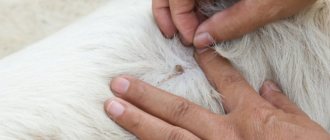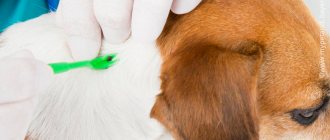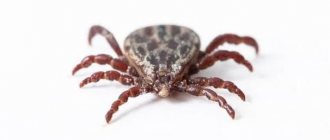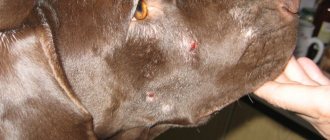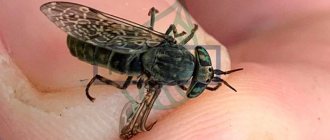The first ticks in nature can be found as early as April. After hibernation, like all living beings, they need food - fresh blood of animals and people. Ticks are most active in the month of May. With the onset of the warm season, the number of diseases caused by tick bites in dogs increases sharply. With the onset of spring, dog owners begin to worry about how to protect their pet from this problem by any means. A tick bite in itself is not so terrible for a dog; dangerous pathogens are contained in the tick’s saliva, which can cause a number of dangerous and sometimes fatal diseases for a dog. Dogs walking through tall grass or dense bushes are especially at risk, where they are especially likely to pick up a tick. Therefore, when returning from a walk, it is necessary to carefully examine the dog’s fur. A tick that has just attached itself to a dog's skin is about the size of a pinhead. Over time, after he drinks blood, he grows to the size of a bean and is impossible not to notice.
General information about ticks . Ticks (Acarina) are small (0.1-30 mm) arthropods of the arachnid class (Arachnoidea) belonging to the largest group in the arthropod subclass, their number reaches 50 thousand species, most of which do not cause any harm to humans and animals. Ticks that parasitize dogs are usually classified as carnivorous parasites, leading to the development of allergies, dermatitis, bacterial and viral diseases
Some ticks that attack dogs drink blood, others chew the skin, and others feed on skin secretions and lymph. Dogs are most often parasitized by three types of ticks:
- Ixodidae (Ixodidae) are the largest ticks, which in a hungry state reach 2-3 mm in length, and after sucking blood - up to 1-1.5 cm
- Scabies (internal, ear).
- Subcutaneous (demodectic).
The most dangerous to the life of dogs in the spring are considered to be ixodid ticks, which are carriers of dangerous blood-parasitic diseases (borreliosis, encephalitis and piroplasmosis).
Consequences
Ticks become active during the first spring warmings. In the south of Russia this is the end of February, in the middle zone and in the north - April-May. In the heat, the parasites lose activity, but with the first autumn rains they resume.
Ixodid tick
How dangerous is a tick bite for a dog?
Eggs require animal protein to mature. Ixodid ticks have adapted to obtain it from the blood of mammals. The parasites attach themselves to the animal’s skin and secrete painkillers so that the dog does not notice the presence of guests. To prevent blood clotting, the parasite secretes anticoagulants.
How long does a tick live on a dog? The parasite needs time to choose a secluded place, attach to the skin, make a puncture and suck on. Most often, the tick is attached to the folds of the skin or ears. The female is saturated with blood for 6 days and increases in size a hundred times. In total, the parasite can live on a pet for up to 10 days.
If a dog has a lot of ticks attached to it, anemia develops. The pet weakens, becomes defenseless against the permanent inhabitants of the skin - coccus bacteria, and develops dermatitis and abscesses. The main danger to animals and humans are sexually mature individuals, mainly females, who carry pathogens.
Ixodid ticks prefer secluded places
It is dangerous for the parasite to get inside. If a dog accidentally swallows a tick, it will dissolve and pathogens will enter the bloodstream.
What diseases can ticks transmit to dogs?
The following infectious diseases pose the greatest danger:
- Piroplasmosis (babesiosis). Caused by protozoan microorganisms that settle inside red blood cells.
- Bartonellosis is caused by motile bacteria that parasitize red blood cells.
- Borreliosis or Lyme disease is caused by spirochetes.
- Ehrlichiosis is caused by protozoan microorganisms.
Ixodid ticks are dangerous not only for dogs. In the steppe regions, through the bites of arthropods, people become infected with Crimean fever, and residents of the taiga become infected with tick-borne encephalitis.
Can a dog die?
If you find a tick on your dog, don't panic. Not every parasite is infected. In addition, the arthropod needs time for protozoan microbes or pathogenic bacteria to move from the intestines to the salivary glands.
However, if you missed the moment of tick attachment and find it already sucking blood, consult a doctor.
If the arthropod is infected with Babesia, the dog may die.
When infected with other pathogens, recovery is possible, but death cannot be ruled out after a long illness.
The tick sucked blood
The danger of tick-borne infections for humans and dogs
Ticks are not harmless parasites. They are capable of transmitting a lot of infections. Tick-borne encephalitis is more dangerous than the others. Against the background of the virus, the dog develops fever, headache, muscle pain, disturbances of consciousness and even paralysis.
Also dangerous is borreliosis, a disease accompanied by severe intoxication and heart problems, as well as an acute allergic reaction at the site of the bite.
Another dangerous complication for humans and dogs is piroplasmosis. The disease provokes the destruction of red blood cells with a pronounced clinical picture:
- thirst;
- lack of appetite;
- stomach upset;
- rise in temperature;
- dyspnea;
- yellowing of mucous membranes.
Ticks can carry tularemia, Q fever, typhus and relapsing fever, and you can die from each of these diseases. Therefore, you should not underestimate the danger of a tick bite, and it is always better to be on the safe side by getting tested.
All the diseases described and their consequences are relevant for both dogs and humans. Therefore, the owner of the animal must be careful when communicating with his pet. If you are inspecting fur and skin for the presence of parasites, it is better to do it with gloves. You need to lay down an oilcloth in advance so that the parasites fall on it, they can be seen and can be caught.
But don't be afraid right away. Ticks have now become very active - they appear after the first frost and go away only when snow falls in winter, but this is not a reason not to walk the dog or do it in a protective suit. Ordinary care and care of the animal will avoid serious consequences.
Symptoms and signs
Babesia
1. The incubation period for piroplasmosis is from 1 to 3 weeks. Babesia settle in red blood cells and feed on their contents. When they have eaten everything, they move to the next cage.
The following forms of the disease are distinguished:
- Lightning fast, the animal dies suddenly without clinical symptoms.
- Manifest, characterized by the following signs: after a tick bite, the dog experiences convulsions;
- refusal to eat;
- yellowness of mucous membranes;
- temperature 42°C;
- tachycardia;
- dark brown urine;
- paralysis of the hind limbs.
2. Bartonellosis is characterized by a chronic course. Months after the bite, the following symptoms develop:
- vomiting, diarrhea;
- conjunctivitis;
- myocarditis;
- pathologies of the mucous membranes - rhinitis, stomatitis; gingivitis.
3. Borreliosis develops 3-4 weeks after the bite. The disease is characterized by the following symptoms:
- lameness, joint pain;
- fever;
- tachycardia;
- paresis of limbs;
- convulsions;
- a characteristic symptom is ring-shaped redness after a bite or erythema migrans, which disappears and appears on another part of the body.
4. Ehrlichiosis is characterized by inflammation of blood vessels - vasculitis. Clinical signs are as follows:
- apathy;
- hyperthermia - 41° C;
- purulent rhinitis and conjunctivitis;
- hemorrhages on mucous membranes and non-pigmented skin;
- thrombocytopenia.
Watch the video:
When should you contact a veterinarian and what will he do?
You should contact your veterinarian if you suspect a tick bite. The fact is that even a successfully removed tick could be a carrier of infection.
Important information!
Save the tick so you can give it for analysis and not worry about the health of your four-legged friend.
Also reasons to contact a veterinarian are:
- The dog is very restless.
- Active hair loss.
- Redness of the skin.
- Complete refusal of food.
- Signs of pain (whining, howling, the dog tries to hide, bury its head, etc.).
If these signs persist for more than a day, then you need to show the dog to a doctor and get tested. The veterinarian will be able to correctly diagnose and select treatment to eliminate the pathogen and alleviate the symptoms of the disease.
What to do
To save a dog after a bite, you need to provide first aid, remove the tick, place it in a bottle and take it to the clinic. There they will conduct a study to detect the DNA of pathogens and prescribe treatment.
If the tick turns out to be free of contagion, observe the dog and remember that pathological symptoms may appear several months after the bite.
First aid for a bite at home
If you find a tick, it must be safely removed.
Don’t panic, even if the arthropod is infected, it takes a day or more for the pathogens to reach the salivary glands of the parasite.
However, one cannot be careless. There may be microorganisms inside the tick that can cause human illness. When crushed, protozoa or bacteria can enter the bloodstream through mucous membranes or skin pores. Therefore, wear gloves.
The opinion that a tick can be killed by lubricating the spiracles with oil is unfounded. The arthropod can live without oxygen for more than a day. During this time, pathogens will enter the bloodstream. Applying an insecticide to the parasite does not always help. The tick will not die soon, but the dog will have time to become infected.
Do not remove an attached parasite with tweezers.
If limbs or the head remain in the wound after a bite, inflammation will develop.
Use professional tick removers.
I tried to pull out the tick with Anti-Tick tweezers. I did not like. The inflated parasite burst, blood sprayed out, it’s good that he dodged and didn’t get a jet in his eyes.
Anti-mite
Perhaps this is my subjective opinion. But Tik Twister delighted me. I turned the tick out the first time.
Tick Twister
The device resembles a nail puller and costs about 160 rubles. Watch the video and rate.
Recommended reading:
How to remove a tick from a dog?
If you removed the parasite carelessly, after the tick bite a lump may form that is dense and painless to the touch.
Most often, the tumor does not cause harm and is an allergic response to the secretions left by the arthropod. Perhaps the affected area was itchy and the pet scratched it. But the red spot spoils the appearance and can remain at the site of the bite for up to six months.
In any case, observe your pet for 15-20 days. If the dog's behavior has not changed, the mucous membranes have not turned pale or yellowed, it eats well, is active and cheerful, everything is fine.
If a tick leg remains in the wound , the formation will gradually resolve. But when the head remains, there is a high probability of suppuration and the formation of an abscess. Do not fix the defect yourself. You may cause skin irritation that may result in eczema or another type of dermatitis that is difficult to treat. Visit a veterinary hospital and take the medicine prescribed by your doctor.
When you find a dead tick on your dog , pay attention to its size. If it has sucked blood, then take the parasite to a hospital for examination to determine what contagions are inside it. If the arthropod is small, test anyway. You may have used acaricides that killed the parasite. Or the dog snapped his teeth and crushed the arthropod. But there is no guarantee that other ticks will also die. Therefore, it is better to know whether he is infected or not?
I foresee questions about what to do when you are in the forest, at the dacha, there are no veterinary clinics around, and a tick has bitten your dog? Responsible dog breeders, before going into nature, go to a hospital so that the pet can be given an antiprotozoal drug, for example, Piro-Stop, for preventive purposes.
The veterinary industry produces antiprotozoal drugs that are used to kill Babesia after a tick bite based on imidocarb or diminazene aceturate.
Imidocarb derivatives - Piro-Stop, Forticarb, Babezan are produced in solution, are relatively harmless and high in cost (a 10 ml bottle of Piro-Stop - 524 rubles). After opening the container, the medicine must be developed within 28 days.
Medicines based on diminazene aceturate - Azidine, Berenil, Veriben, Pirosan - are produced in powders that are dissolved before use. The drugs are effective and inexpensive (2.4 g of Azidine sells for 30 rubles), but have side effects.
If you risk using the drugs yourself, there is a high probability that you will save the dog, but make it disabled. On the Internet you will definitely run into advice from amateurs like yourself. Therefore, contact your veterinarian by phone and follow his instructions.
How to remove a tick from a dog's body?
In order to remove a tick from a dog’s body, you must first drop vegetable oil, gasoline, alcohol onto the bite site and leave it on the skin for several minutes. After these procedures, the tick will fall off on its own or weaken its grip and we will remove it using tweezers. It is best to grab the tick with tweezers in the head area and begin to twist it so that the tick’s head does not remain in the dog’s body.
Removal using thread. We tie the tick with a thread on both sides and, as in the previous case, begin to carefully and slowly unscrew it from the skin. After removing the tick, in order to prevent the spread of infection, the wound must be treated with a 5% iodine solution.
Removing ticks using special shampoo. To do this, you will need to buy a drug at the pet store that kills tick larvae and weakens the effect of the tick itself. Any remaining ticks after washing will need to be removed manually. However, the dog owner should in no way think that after removing the tick from the dog’s body, the danger of its infection with one or another infectious disease has completely disappeared. Infectious diseases, depending on the type of infection, can occur in a dog after several days or months.
Treatment
The professional approach to the treatment of piroplasmosis in the Russian Federation and abroad is different.
The European approach is to inject an imidocarb-based drug if symptoms of piroplasmosis occur. The dog is monitored for 2 weeks. If your pet is feeling good, there is no need to do anything. Otherwise, the injection is repeated. Imidocarb protects the dog from subsequent arthropod attacks.
If the first injection coincides with darkening of the urine, an antimicrobial drug containing Doxycycline, Azithromycin or erythromycin is prescribed. Antibiotics destroy synergistic microflora. After completing the course, the dog is temporarily transferred to veterinary food with prebiotics to restore digestion.
In Russia, a different treatment regimen has been adopted. Diminazene aceturate derivatives are mainly used. To maintain the function of the liver, kidneys, and heart, maintenance therapy is carried out through droppers. Antibiotics are widely used. Veterinarians practice additional injections of antiprotozoal drugs. The liver suffers. The situation is corrected with hepatoprotectors.
I recommend using Hill's l/d high-calorie and low-protein veterinary nutrition for the treatment of liver pathologies to restore digestive functions.
Despite the dissimilarity of symptoms and pathogens, the treatment regimen for bartonellosis, borreliosis and ehrlichiosis is approximately the same. In all situations, a course of antibiotic therapy with Doxycycline is used.
If the causative agent of the disease is protozoan microorganisms, an injection of Imidocarb is given. General strengthening agents, hepatoprotectors, and B vitamins are used.
To restore digestive functions, use Hill's l/d or Royal Canin Hepatic medicinal food.
Symptoms of encephalitis in dogs
Of course, encephalitis is primarily dangerous for humans, but if the immune system is weakened, the dog can also get sick. The bite of an encephalitis tick causes severe symptoms. The incubation period is about 2-3 weeks. Typically, there is an increase in temperature, convulsions, impaired motor functions, and paralysis. A characteristic symptom is hypersensitivity of the head and neck, severe pain. A change in mood may occur - apathy or aggression, and later - paralysis of the facial and eye muscles. There is obvious brain damage, and since there is no specific treatment for encephalitis for dogs, the prognosis is unfavorable: almost one hundred percent death. Symptoms may go away after the first deterioration, but this is not a cure, but a sign of a suppressed immune response. The encephalitis tick has no special signs.
Prevention memo
Prevention of tick attacks on dogs and the diseases they carry is as follows:
- Destruction of the parasite in the natural environment. You cannot eliminate ticks in forests and parks at your discretion, but you have the right to carry out decontamination in your personal garden or summer cottage. The drug Medilis-Ziper ensures the destruction of parasites and protection against the appearance of new ones for 1-1.5 months. 12 ml of concentrate is consumed per hundred square meters. The cost of 0.5 liters of pesticide is 1200 rubles. In addition to the above, the following acaricidal agents are in demand: Argus Garden;
- Dobrokhim FOS;
- Dr. Klaus;
- Ram.
If you have any questions, I will answer in the comments.
Next: Large dog breeds with photos and names
